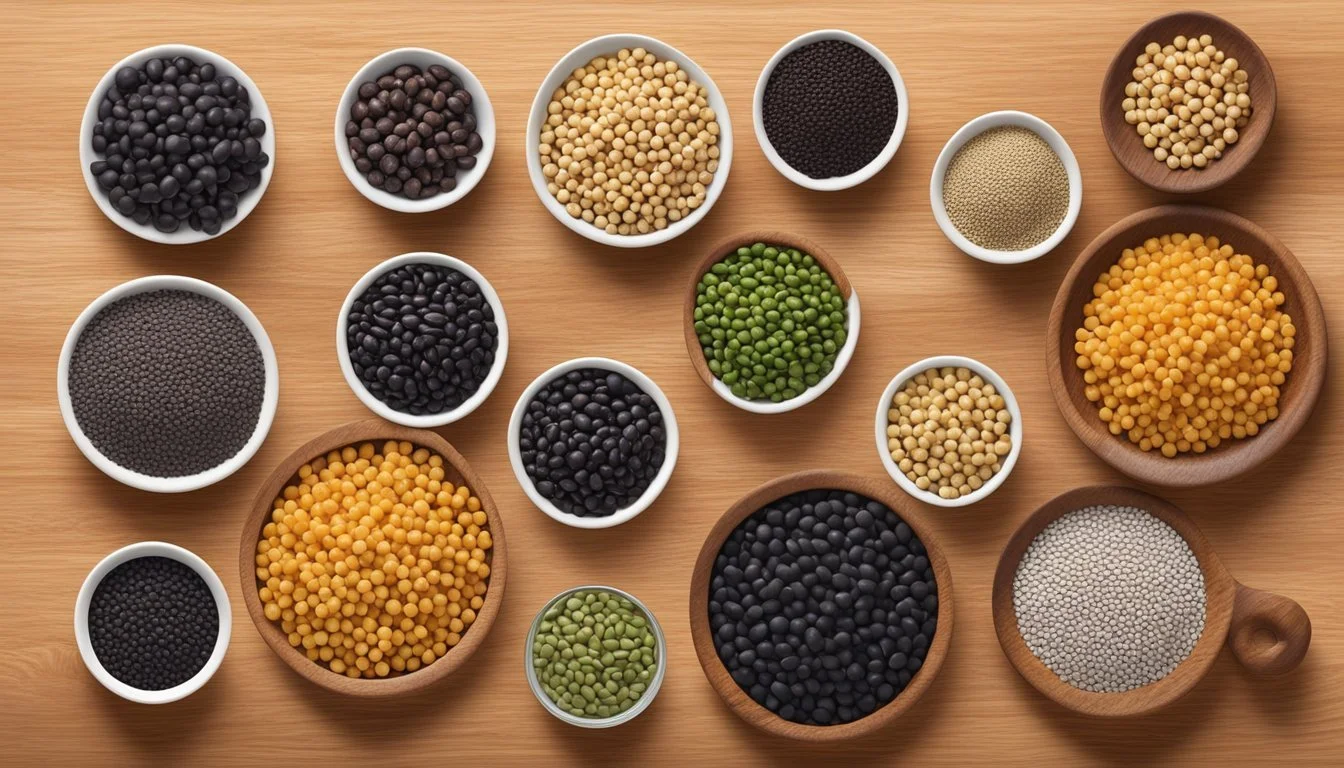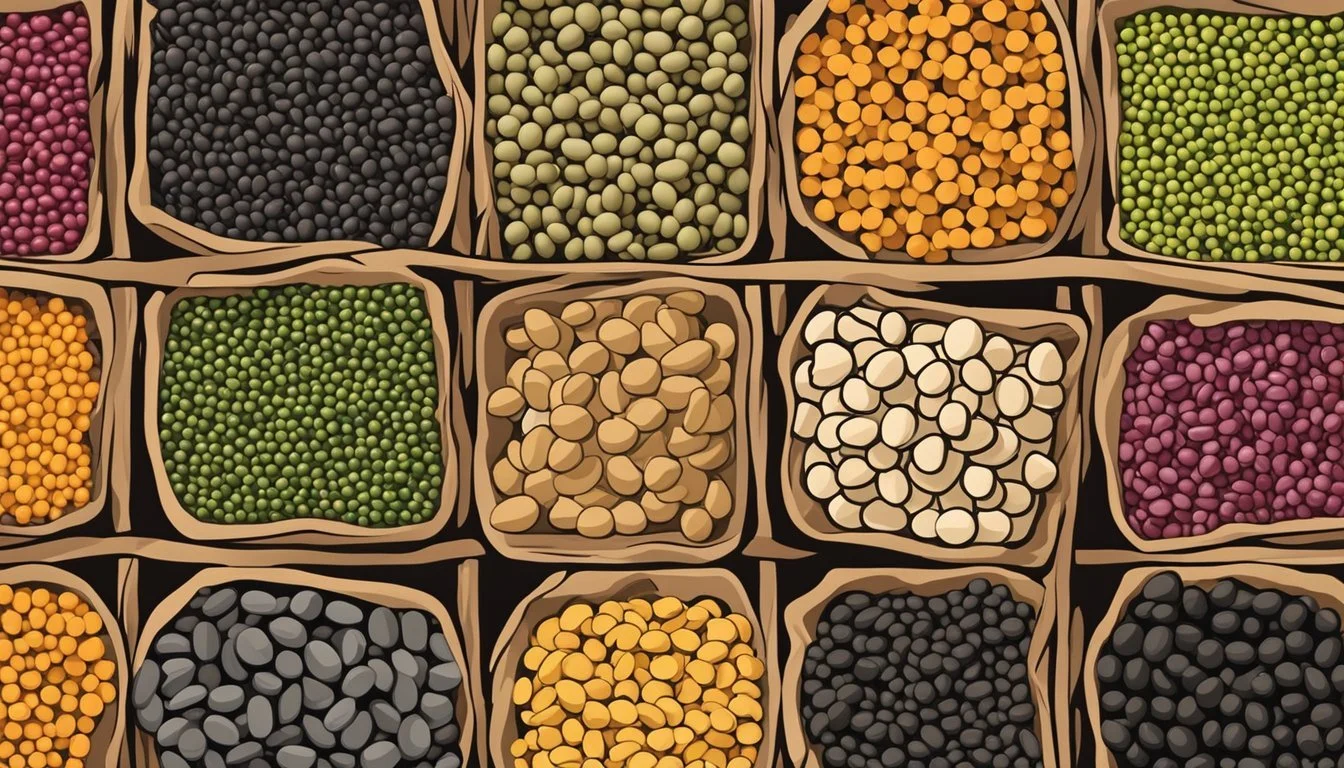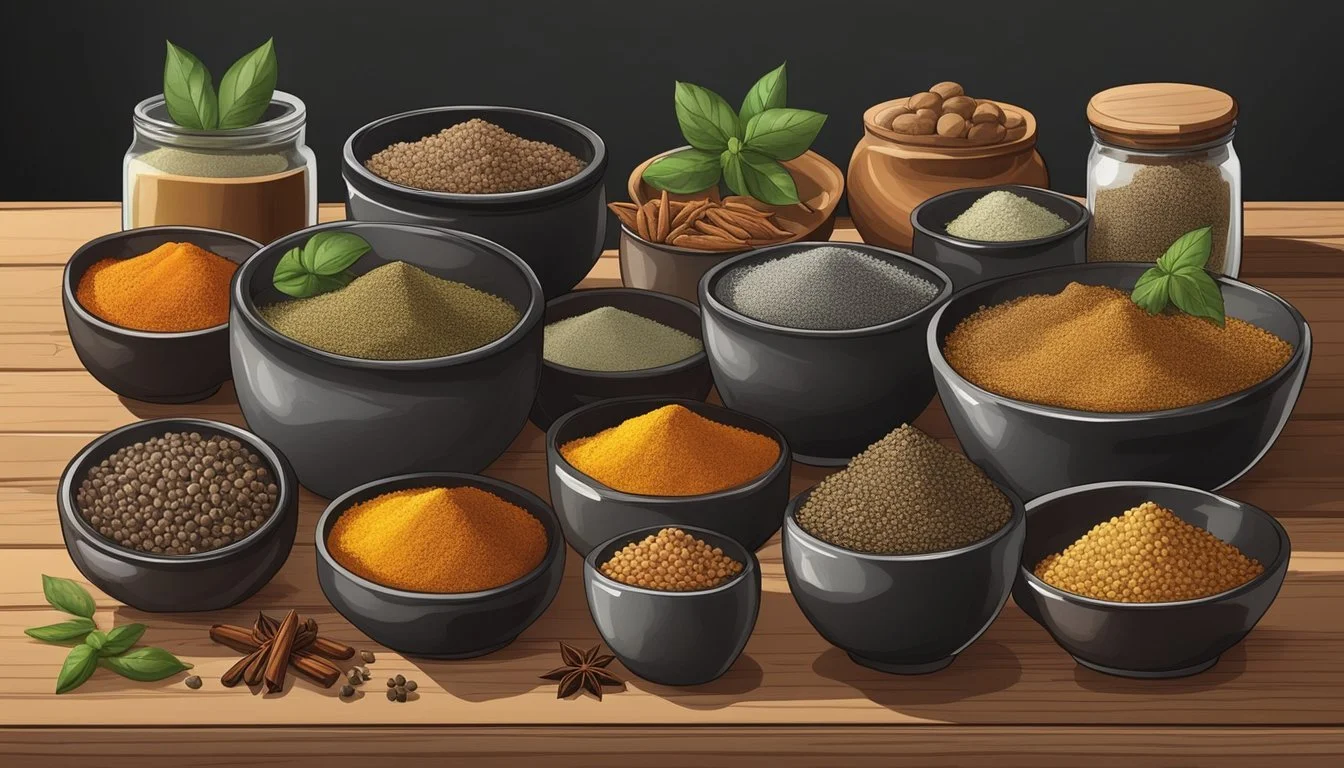Black Gram Substitutes
Best Alternatives for Cooking and Nutrition
Black gram, also known by its botanical name Vigna mungo and more commonly as urad dal in Indian cuisine, is a staple ingredient beloved for its rich, earthy flavor and versatile culinary uses. Native to India, this small, black legume is essential in traditional dishes such as dal, dosa, and idly. When you find yourself out of black gram but still craving that authentic taste, there are several substitutes that can seamlessly fill the gap.
Black Beluga lentils, adzuki beans, and split yellow peas are excellent alternatives, each bringing their unique texture and nutritional benefits to your recipes. Black Beluga lentils, in particular, mimic the appearance and slightly nutty taste of black gram, making them a favored option. For those with dietary restrictions or looking for a gluten-free option, black gram flour and urad dal flour can come in handy.
Semolina offers a unique twist for recipes that traditionally require black gram, particularly in dishes like dosa. It isn't unheard of to use various nuts, like peanuts or cashews, especially in tempering, to achieve a similar richness. While the black gram's distinct taste and texture are hard to perfectly replicate, these substitutes ensure you can continue enjoying the essence of Indian cuisine.
Understanding Black Gram
Black gram, also known as Urad Dal, is a crucial ingredient in Indian cuisine. It is rich in essential nutrients and is commonly used in a variety of dishes, providing unique textures and flavors.
Nutritional Profile of Urad Dal
Black gram is a powerhouse of nutrition. It is particularly high in protein, making it a valuable source for vegetarians.
Protein: Approximately 25 grams per 100 grams.
Fiber: Contains about 18 grams per 100 grams, essential for digestive health.
Iron: Contributes to 40% of the daily recommended intake.
Potassium: Supports heart health with around 983 mg per 100 grams.
Magnesium and Calcium: Important for bone health, adding up to 138 mg and 138 mg respectively.
Copper and Zinc: Enhance immune function and assist in metabolism.
This dense nutritional profile makes black gram beneficial for various health conditions and overall well-being.
Culinary Uses in Indian Cooking
In Indian cuisine, black gram is highly versatile. It is used in traditional recipes like dal makhani and idli.
Dal Makhani: A creamy lentil dish, often enjoyed with naan or rice.
Idli and Dosa Batter: Ground into a paste, it ferments with rice for fluffy idlis and crispy dosas.
Chutneys: Sometimes, dry roasted and added for a nutty flavor.
This ingredient’s versatility extends to soups and stews, adding both flavor and texture.
Textures and Flavors of Black Gram
Black gram is appreciated for its unique textures and earthy taste.
Raw State: Hard and requires soaking for at least 4-6 hours.
Cooked State: Turns soft, creamy, and slightly sticky, making it ideal for curries and stews.
Flavor Profile: Earthy and slightly peppery, it complements a variety of spices well.
These attributes make black gram not only a nutritious choice but also a flavorful one, enhancing the quality of many dishes.
Popular Black Gram Dishes
Black gram, known for its rich flavor and nutritional benefits, features prominently in various dishes across Indian cuisine. From the creamy Dal Makhani to the fermented delights of idli and dosa, black gram's versatility shines in these traditional recipes.
The Role of Urad Dal in Dal Makhani
Dal Makhani, a North Indian staple, centers around the use of whole black gram (Urad Dal) and kidney beans. The dish originates from Punjab and is characterized by its creamy, buttery texture.
To prepare Dal Makhani, slow-cooked Urad Dal is simmered with tomatoes, ginger, garlic, and a variety of spices, including garam masala. Adding cream and butter enhances the dish’s richness.
It pairs well with flatbreads like Naan or roti, making it a beloved accompaniment in festive and everyday meals alike.
Preparing Traditional Idli and Dosa
In South Indian cuisine, black gram is integral for creating the batter for idli and dosa. These fermented dishes rely on a mixture of Urad Dal and rice, often in a ratio of 1:3.
For idli, the batter, once fermented, is steamed into fluffy, soft cakes. Dosa, on the other hand, is a thin, crispy crepe cooked on a flat griddle. The fermentation process aids digestion and adds a slight tangy flavor.
Both idli and dosa are typically served with sambar and a variety of chutneys, including coconut and tomato chutney, highlighting their place in South Asian cuisine.
Snacks and Sides: Papadum and Naan
Papadum, a thin, crispy flatbread, often accompanies Indian meals as a snack or side. Made from Urad Dal flour, it is seasoned with spices and either fried or roasted. Its crispiness adds a textural contrast to soft curries and dals.
Naan, while typically made from wheat flour, can also incorporate Urad Dal flour to enhance flavor and texture. This leavened bread, cooked in a tandoor, perfectly complements creamy dishes like Dal Makhani and various curries. Its soft, pillowy texture makes it ideal for mopping up rich, flavorful sauces.
These dishes demonstrate the versatility and significance of black gram in Indian culinary traditions.
Choosing a Substitute for Black Gram
When selecting a substitute for black gram, consider factors like texture, flavor, and nutritional content. Various substitutes offer unique characteristics that can closely replicate black gram in different recipes.
Factors to Consider When Selecting Substitutes
Texture and Flavor: Some substitutes have a creamy texture similar to black gram, such as split yellow peas. Others might have a slightly different taste but can still complement the dish well, like adzuki beans.
Nutritional Content: If nutritional value is important, look for substitutes high in protein and fiber. Split yellow peas and mung beans are nutritious options that match black gram's profile.
Cooking Time: The cooking time can vary significantly. Split yellow peas cook faster, while whole black lentils might take longer. Adjust your recipe accordingly to ensure the substitute’s texture and flavor is well integrated.
Top Substitutes by Similarity in Taste and Texture
Mung Beans: Often used in Indian cuisine, mung beans have a mild flavor and soft texture. They are an excellent substitute in recipes like dal and dosa.
Black Beluga Lentils: These lentils closely resemble black gram. They have a firm texture and rich flavor, making them perfect for salads and soups.
Adzuki Beans: Known for their sweet flavor, adzuki beans can be used in both savory and sweet dishes. They provide a different flavor profile but work well in recipes requiring a creamy texture.
Split Yellow Peas: Also known as toor dal, they offer a mild flavor and soft, creamy texture. They are ideal for dal and other similar dishes due to their similarity in texture to black gram.
Choosing the right substitute depends on the specific requirements of your recipe and personal preferences. Experiment with these options to find the best match for your cooking needs.
Legumes as Alternatives
When looking to replace black gram, legumes such as red lentils, mung beans, and chickpeas are excellent alternatives. They each offer unique flavors and nutritional benefits that can fit seamlessly into various recipes.
Red Lentils: A Versatile Choice
Red lentils are a popular substitute due to their mild, nutty flavor and quick cooking time. They contribute a creamy texture to soups and stews. Nutritionally, red lentils are rich in protein and fiber, making them a valuable addition to a balanced diet.
They break down easily when cooked, which is ideal for dishes like dals and curries. Additionally, their vibrant color can enhance the visual appeal of a meal. Using red lentils as a replacement for black gram works well in recipes that benefit from a smoother consistency.
Mung Beans and Green Gram
Mung beans, also known as green gram, are another viable alternative. These small, green legumes are highly nutritious, providing a good source of protein, fiber, and essential vitamins. Their flavor is mild and slightly sweet, which can complement a variety of dishes.
Green gram is particularly effective in recipes that require a firmer texture, such as salads and stir-fries. They can also be sprouted, adding a fresh, crunchy element to dishes. This versatility makes green gram a suitable replacement for black gram in both cooked and raw applications.
Chickpeas and Toor Dal
Chickpeas are an excellent substitute due to their nutty flavor and firm texture. They are packed with protein and fiber, aligning well with the nutritional profile of black gram. Chickpeas can be used in curries, soups, and as the base for dips like hummus.
Toor dal, also known as split pigeon peas, is another worthy alternative. It has a mild taste and cooks down to a creamy consistency. Toor dal is often used in traditional Indian dishes like sambar and dals, making it a fitting substitute in similar recipes. Both chickpeas and toor dal provide distinct flavors and textures that can enhance various dishes while maintaining nutritional benefits.
Grains and Seeds Substitutes
When looking for substitutes for black gram, there are many grains and seeds that offer similar benefits and taste profiles. These alternatives can provide gluten-free options and various flavors to suit different recipes.
Quinoa and Millet
Quinoa is a popular grain known for being gluten-free and nutritionally rich with high protein content. Its mild, nutty flavor makes it versatile in both savory dishes and salads.
Millet also offers a gluten-free option and has a slightly sweet, nutty flavor. It works well in porridges and can be cooked in a manner similar to rice. Both grains are easy to prepare and absorb flavors well, making them suitable alternatives to black gram.
Buckwheat and Barley
Buckwheat is another gluten-free grain, recognized for its strong, earthy taste. Commonly used in pancakes, porridge, and soba noodles, buckwheat provides a distinctive flavor that can enrich a variety of dishes.
Barley, although not gluten-free, is high in fiber and has a chewy texture. It is often used in soups and stews, adding both texture and nutritional value. When replacing black gram, barley can also be used to create hearty, comforting dishes.
Nut Substitutes for Creaminess
When aiming for a creamy texture in vegan recipes, cashews and peanuts stand out as versatile and effective substitutes. Both offer unique properties that enhance various dishes, providing rich textures and flavors.
Cashews as a Thickening Agent
Cashews are widely praised for their ability to create a creamy texture when used in vegan cooking. When soaked and blended, they form a smooth paste that can thicken sauces, soups, and desserts. This makes them an excellent choice for dairy-free cream sauces, vegan cheesecakes, and creamy soups.
Their mild flavor doesn't overpower the dish, allowing the other ingredients to shine. Cashews also blend seamlessly, avoiding any grainy texture that some other nuts may introduce. For best results, use raw cashews and soak them in water for a few hours before blending.
Peanuts in Vegan Preparations
Peanuts bring a different but equally valuable quality to vegan dishes. They add not only creaminess but also a distinct, slightly sweet flavor that complements both savory and sweet recipes. Peanut butter can be mixed with a bit of water or plant-based milk to create a creamy base for sauces, smoothies, and even soups.
Peanut-based sauces are common in various cuisines, including African and Asian dishes, where they are used to add both flavor and texture. While peanuts are more robust in flavor compared to cashews, this can be an asset in recipes where a bold taste is desired.
Using unsweetened, natural peanut butter is recommended to avoid added sugars and oils that could alter the dish's flavor profile.
Understanding the Cooking Process
To successfully substitute black gram in recipes, it's crucial to grasp the cooking techniques involved. Different substitutes require specific soaking and boiling times, and the choice between pressure-cooking and simmering can affect the final dish's texture and flavor.
Soaking and Boiling Times for Substitutes
Urad Dal, black beluga lentils, and adzuki beans each have unique soaking and boiling requirements.
Urad Dal needs to be soaked for at least 4-6 hours or overnight. Following the soak, it should be boiled for about 30-40 minutes until tender.
Black beluga lentils do not require soaking but should be boiled for 25-30 minutes to achieve a firm but tender texture.
Adzuki beans benefit from soaking for 1-2 hours and should be boiled for about 45-60 minutes until they are soft yet holding their shape.
Cooking Methods: Pressure-Cooking vs. Simmering
Pressure-cooking dramatically reduces cooking time and helps retain nutrients.
For Urad Dal, pressure-cook on high pressure for about 10-15 minutes for soft, sticky results. Simmering takes longer, approximately 30-40 minutes, but produces a creamier texture.
Black beluga lentils pressure-cooked for 5-7 minutes save time compared to the standard 25-30 minutes of simmering. Pressure-cooking maintains their slight firmness.
Adzuki beans benefit from 15-20 minutes in a pressure cooker, preserving more nutrients compared to a 45-60 minute simmer. This method yields a soft but not mushy texture.
Choosing the right method based on the desired texture and time availability makes the cooking process efficient and effective.
Spices and Flavor Enhancers
Incorporating spices and flavor enhancers like garlic, ginger, and tomatoes can significantly improve the taste profile of dishes made with black gram substitutes.
Tempering with Indian Spices
Tempering, or “tadka,” is a key culinary technique in Indian cooking used to flavor dishes. It involves heating oil or ghee and adding whole spices such as cumin seeds, mustard seeds, and turmeric.
Cumin seeds add a warm, earthy flavor.
Mustard seeds offer a pungent and slightly spicy taste.
Turmeric provides a distinct color and slightly bitter undertone.
These spices should be added in the correct sequence and cooked until they release their aromas, enhancing the dish significantly.
Using Garlic, Ginger, and Tomatoes
Garlic, ginger, and tomatoes serve as foundational ingredients in many recipes, imparting depth and complexity.
Garlic contributes a robust and pungent flavor that melds well with spices.
Ginger adds a spicy and slightly sweet note.
Tomatoes offer acidity and umami, balancing the flavors.
These ingredients can be sautéed together to create a rich base. Using freshly crushed garlic and ginger, along with ripe tomatoes, leads to the best results. This combination is especially useful in gravies and curries where black gram substitutes are used.
Purchase and Storage Tips
When looking for black gram substitutes, selecting high-quality items and storing them correctly is essential. These steps ensure your ingredients are fresh and ready for use in various recipes.
Buying Quality Substitutes
Purchasing quality substitutes can be done at supermarkets, health stores, or through online retailers. Supermarkets typically offer a variety of legumes and grains, including black beluga lentils, adzuki beans, and split yellow peas.
To guarantee freshness, check the packaging for expiration dates and ensure there are no signs of moisture or pests. Visiting health stores can provide access to organic and specialty options like urad dal flour or black gram flour.
Online retailers often have a wider selection, allowing you to compare different brands and read customer reviews before making a purchase. Always buy from reputable sources to ensure quality.
Storing Legumes and Grains
Proper storage of legumes and grains is crucial to maintain their quality. Keep them in airtight containers to protect against pests and moisture. Glass jars or food-grade plastic containers work best for this purpose.
Place the containers in a cool, dry, and dark location, such as a pantry or cupboard. Avoid storing them near heat sources like stoves or direct sunlight, as heat can cause spoilage.
Labeling containers with the purchase date can help track freshness. For long-term storage, consider refrigeration or freezing, especially for items like black gram flour or urad dal flour. This helps retain their nutritional value and extend their shelf life.








